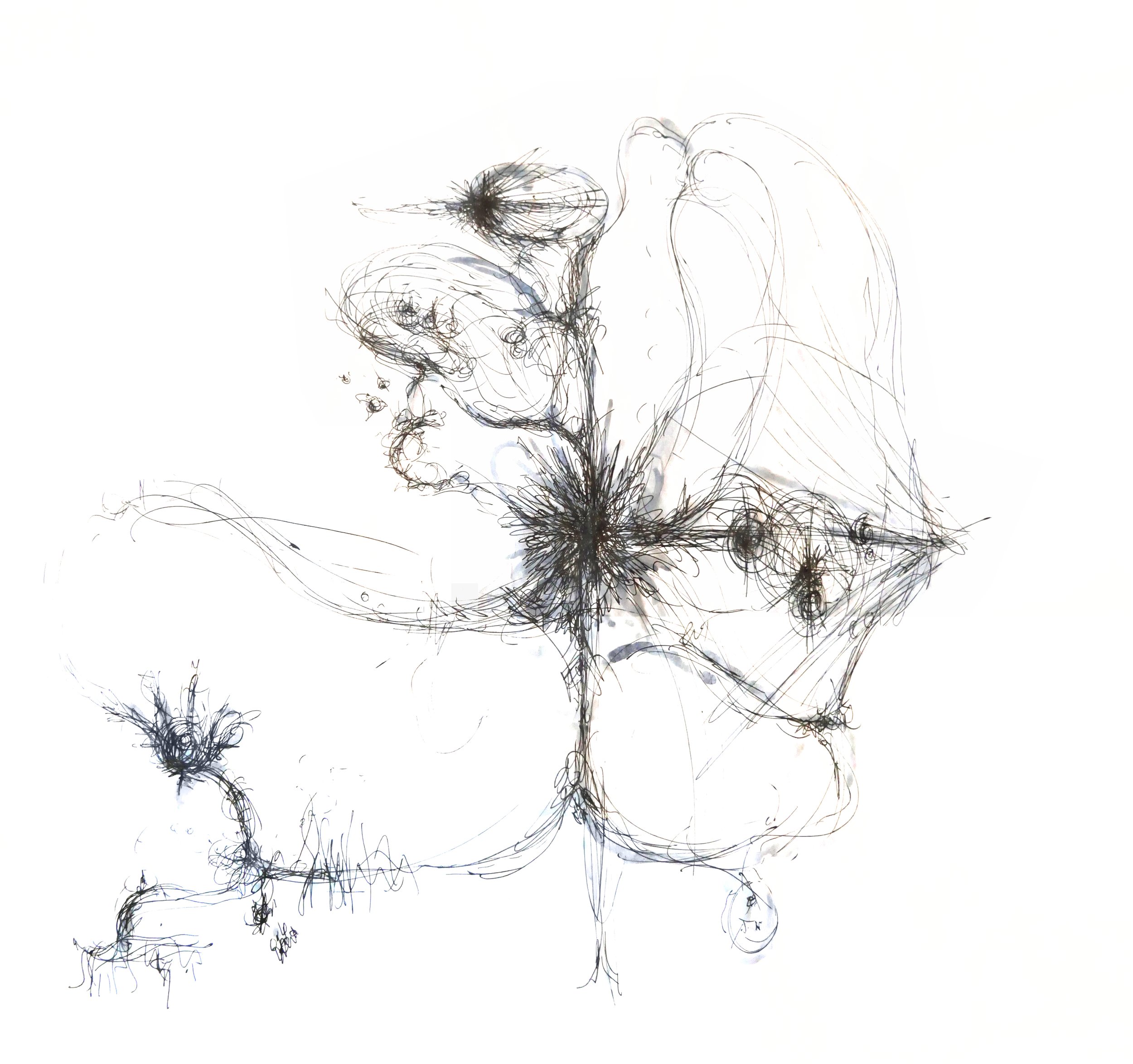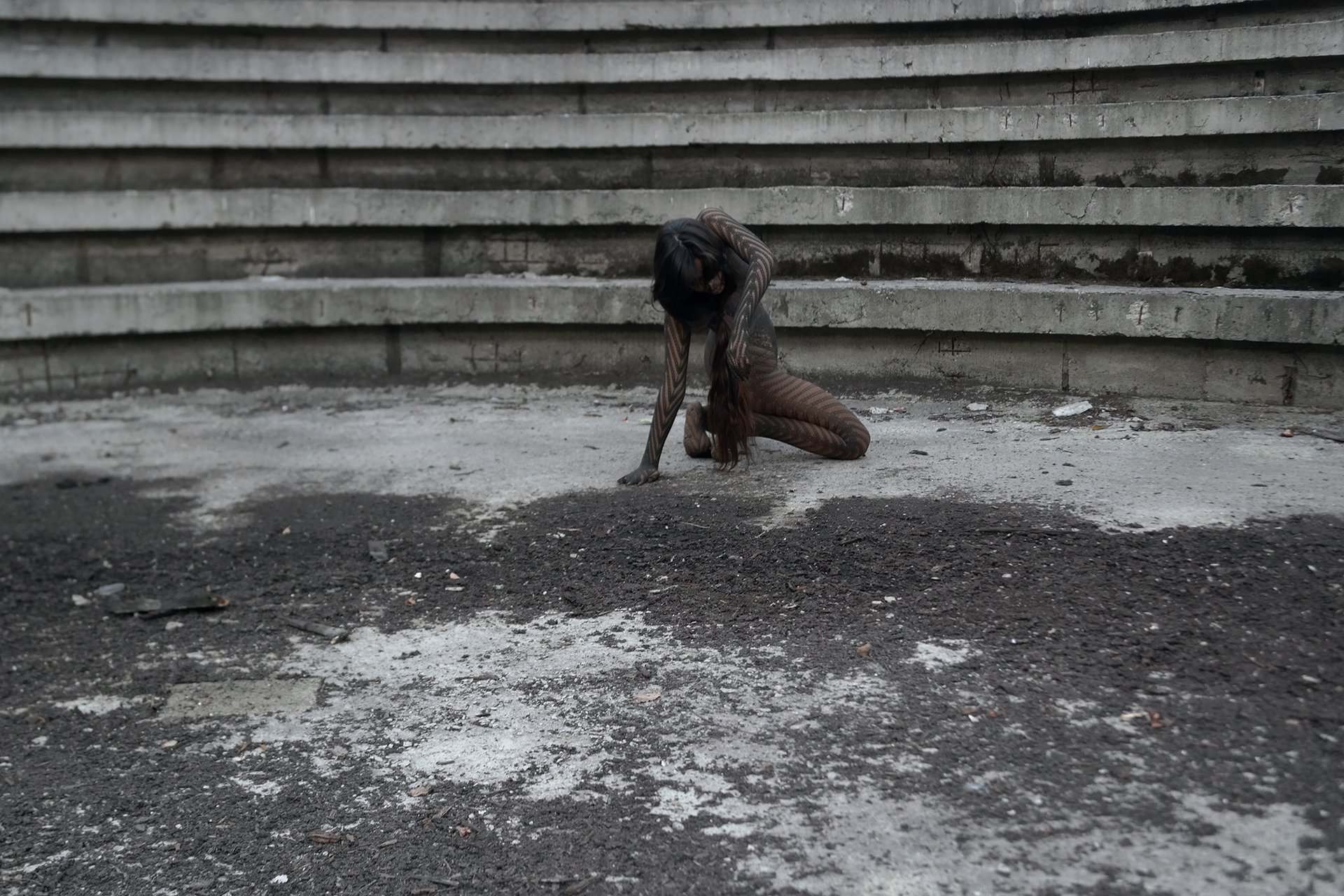Ohlsson & Dit-Cilinn | Blurring The Human-Nature Boundary
On a blank sheet of paper, dark grey and blue traces of pencil converge and then diverge, swimming freely to and fro, forming various organic shapes; the overall composition seems either floral or vascular, amphibian or microbial. This is a drawing that the Swedish artist duo Ohlsson/Dit-Cilinn created just for this interview. It depicts the magnetic fields of the places they frequent in their town. The aura of each spot merges into a larger flowing cosmos that, to me, recalls Yggdrasil, the central sacred tree in Norse cosmology. Landscape here becomes sentient and turns into an interconnected space, a space among swamps, herbs, arthropods, between cosmic meditation and spiritual sensibility.
Words by Clement Huang.
The duo Ohlsson/Dit-Cilinn are based in Hindås, a small town in the west of Sweden with only around 3,000 inhabitants, very far from the metropolises in which contemporary artists usually choose to live. For most urban people, the town must feel like a heterotopia in which time and space are different. “The days bleed together, and there is less distinction between your mind and the surroundings. Spending an extended period in the lake house feels like being in the film Solaris,” they say.
Ohlsson/Dit-Cilinn moved to Hindås in 2014. Compared to an urban environment, it is a relatively peaceful place and they “have lost some of (their) city habits, like eating out or wearing clothes.” For them, forests and lakes are all one big studio for work, where they can immerse themselves, observe the ecosystem, and “make kin” with animals and plants. “Spending time in nature is conducive to this: your skin stroked by ferns, your calves intercepting an ant trail, the smell of wet soil filling every cell of your body.” Getting sweaty and taking a dip in the water before going home makes them feel born again. As partners in both work and life, the two seem to have maintained a rather stoic and ascetic lifestyle. They seldom use mobile phones, never buy new clothes, and thus, rarely have any anxiety caused by material desires. Although they have never quarreled over art, they admit that making art when there’s a deadline can be stressful. “Sometimes it feels like the seed for an artwork is implanted in us by some inter-dimensional entity that doesn’t care about our relationship or wellbeing. It just wants to be born. That can be rough.” When anxiety happens, luckily, it always helps for them to return to the basics: eating, sleeping, exercising, showering, and snuggling.
Don’t get me wrong: neither “idiorrhythmic”(as Roland Barthes puts it) nor “pastoral” acc1urately describes the artist duo’s lifestyle, their daily routine’s deep interactions with living or non-living creatures, and their rich Nordic sensitivity to omnipresent spirits and souls.
Ohlsson/Dit-Cilinn, Moon Bather, Installation with sand, iron, blood, bone, feathers, glass, plaster, thistles, mushrooms and various beach debris, 345 x 182 x 120 cm
Ohlsson/Dit-Cilinn, Moon Bather, Installation with sand, iron, blood, bone, feathers, glass, plaster, thistles, mushrooms and various beach debris, 345 x 182 x 120 cm
In heels, Glass, clay, stone, oyster shells, resin, rebar, light, 32 x 34 x 21 cm, 2018
Ohlsson/Dit-Cilinn’s installations strike the beholder with their natural magnificence. They are often delicate mélanges of faunal, floral, and human elements that make up a single organic structure. Moon Bather (2018), for instance, uses sand, iron, blood, bone, feathers, glass, plaster, thistles, mushrooms, and beach debris to make a large, uncanny skeleton that lies tranquil and sublime, bathed in the moonlight like Endymion. In Dyn (2020), an amphibian bog priestess rises out of the murk to take her vengeance; her body is made of earth, rust, blood, copper, concrete, found moose bones, pine needles, hooks, lead sinkers, reflective tape, pigments, netting, waxed canvas, ferns, a sickle, wood, clay, and anchors. The duo only use naturally dead animals or roadkill for artworks and try their best to honor the creatures. While the installations are surely (wo)man-made, the human traces are always kept very minimal. When those artificial components are present, they are mostly abandoned or decaying, deprived of their original function. For example, in 2019, Ohlsson/Dit-Cilinn stumbled upon a half-finished amphitheater in Belgrade with a huge golden ohm sign collecting dust in a corner. The building had been abandoned and was populated by stray cats, small lizards, and green bottle flies. This was the site of Dit-Cilinn’s Lucilia, a performance in which she dresses up as a hexapod. “Being at the amphitheater felt like being born from dark dust, creeping and crawling while finding ways to evolve,” she says.
Perhaps there should never have been a boundary between humans and nature, or even between life and non-life. In Scandinavian mythology where cyclic time is a central theme, Líf (life) and Lífþrasir (zest for life) will survive doomsday by hiding in the woods and then repopulate a reborn world. Ohlsson/Dit-Cilinn present their own end-of-the-world scene in the installation Secret Song, a skeletal structure flanked by two high voltage isolators. The installation describes a world inhabited by humans, technology, lichens, insects, and demons, an extended ecology that includes the immaterial realm. The creature that emerged from the chrysalis feeds off the power grid: electricity is its nectar. In the duo’s view, spirit is not divorced from technology, and even prayer and ceremony can be seen as kinds of technology.
Ohlsson/Dit-Cilinn, Secret Song, Yew tree pollen, ETA silk, aluminum, lichen, hemp twine, brooms, high voltage isolators, 400 x 430 x 250 cm, 2019
Ohlsson/Dit-Cilinn, Secret Song, Yew tree pollen, ETA silk, aluminum, lichen, hemp twine, brooms, high voltage isolators, 400 x 430 x 250 cm, 2019
In my imagination, the works of Ohlsson/Dit-Cilinn come from a near future when human activity on the planet will be vanishing, an epoch “undulating with slippery eros and gravid chaos,” in Donna Haraway’s words.
Yet, besides a de-anthropocentric vision of sympoiesis, Ohlsson/Dit-Cilinn’s works are also dedicated to unabashed voluptuous pleasure. Sexuality and sensuality here are idiosyncratic, not the least bit related to penetrative intercourse or pornographic representation. Rather, experiencing their art is like going out naked on a summer evening by the riverside and having the body pervaded by streams of water. Looking closely at their work, there is often an erotic element: in the nipple pierced by a fishhook in Dyn, in the slithering bodies in Clearing the Clouds, and in the phallus dripping resin in Silken Sentience. They wish to hum with the background radiation that fills all space—the frequency that is strange, healing, and ferocious, the echo of the orgasm that sparked the universe. Indeed, the sexuality of plants, humans, and other animals is an expression of that same cosmic force.
Animistic ecstasy is, as Harry Martinson writes, “The firmament’s eternal mystery / and wondrous physics of the constellations / are law, but they are not the gospel truth. / Compassion flourishes at life’s foundations.”
Ohlsson/Dit-Cilinn, DYN, earth, rust, blood, copper, concrete, found moose bones, pine needles, hook, lead sinkers, reflective tape, pigments, net, waxed canvas, ferns, sickle, wood, clay, anchors, 920 x 330 x 200 cm, 2021
Diary by Ohlsson/Dit-Cilinn.
A few years ago we kept a pet mantis named Etera. She was a tiny demon of considerable beauty. Her body was a flowery pink with white dots and chlorophyll-green hind legs. Unlike an ant or other common insects, she was keenly aware of our existence — turning her head 180 degrees and looking at us straight in the eye. After she molted, the old exoskeleton hung like a ghostly jewel amongst the twigs. Emerging from this process she was weak but hungry. We fed her mosquitoes caught in our apartment. Releasing them into her subtropical glass cube felt like a ritual sacrifice. After catching them with her pink mandibles she would first bite their heads off and then eat the rest of the body. After feeding she would dance joyously. It was a mythic drama in miniature.
Etera’s influence is still felt in our work, perhaps most clearly in Secret Song. An installation which was shown this year at UCCA Dune in Hebei, China.
There is this wooded area around a lake close where we live in Hindås. Around midsummer the place is absolutely riddled with thousands of tiny frogs. You cannot take a single step without them scurrying out of the way. Two years ago they cut a lot of those trees down, compromising the habitat. Shortly afterward, we attended an orthodox baptism in Belgrade. Someone in the church had a frog song signal on their phone which rang out over the chanting. It felt like the return of the repressed biosphere. These two events merged to form the impetus behind DYN - an amphibian priestess-bog body risen out of the murk to claim her vengeance.
The clear cut area around the lake one foggy morning.
We came across a cluster of dried henbane in an old paper mill. The plant was very imposing in size as well as smell — not to be fucked with. Henbane has been used medicinally for thousands of years and is still used before surgery to reduce mucous secretions. It was also a common ingredient in flying ointments. In the wall piece Hypnotikon, a branch of henbane hangs behind our old dream-soaked linen sheets.
More nightshades! They seem to love industrial wastelands, so do we. These datura we spotted in Sun Valley, California, while scouring for a car wreck to use in a show called HYDROGENESIS at HILDE LA. Datura is known as a trickster, a plant that lets you taste death and visit the underworld.
Shana Nys Dambrot wrote about the piece that was initiated that day:
‘Its rusted, truncated, marine-marinated body is draped like a Greek goddess, an undertow Ophelia, in a mane of dried kelps. The majestic bird rises up from the car’s slanted roof as if in the moment before taking flight, an undead Brancusi.’
Before leaving Sweden for grad-school in San Francisco, Dit-Cilinn made this stalactite figure called Growth I. It spent a decade in a crate only to emerge last summer in our garage. A desperate rat had gnawed at the plaster and died in the sculpture’s ossified lap.
While on a residency in Mexico we visited the cenotes in the Yucatan area. Swimming around the dark sacral spaces we half expected to see Growth perched amids the flowstone.
In the middle of Belgrade we stumbled upon a half finished amphitheatre with a huge golden ohm sign collecting dust in a corner. The building project seemed to have been abandoned and was populated by stray cats, small lizards and green bottle flies. Dit-Cilinn made a performance there called Lucila which responded to the architecture and its inhabitants.
The story was published in noisé 01 The Solstice.






















